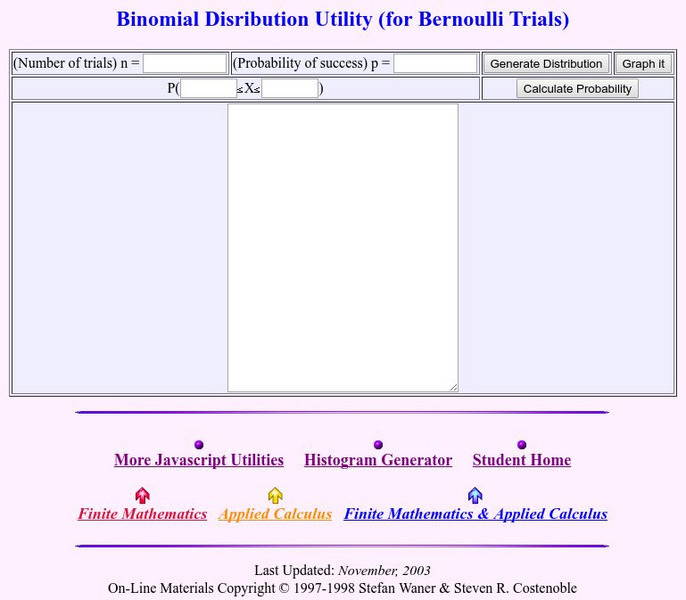Shodor Education Foundation
Spinner
Go round and round to compare theoretical and experimental probabilities. Learners set the number of sectors and the number of spins for a spinner. Then, a table displays the experimental and theoretical probabilities of the spinner for...
Shodor Education Foundation
Two Colors Applet
Find the box with two green balls. The applet uses six balls, three green and three red, and hides them in three boxes. Pupils choose a box and click on it to reveal the color of balls inside. Using the chosen box, the simulation keeps...
Shodor Education Foundation
Racing Game with One Die
Pupils roll a die to figure out which car advances on a race track. They determine the rules for each car moving forward and, given the statistics of the winner, compare if it matches their predictions.
Shodor Education Foundation
Experimental Probability
Spin into a dicey experiment. Pupils use a spinner or a pair of dice to determine the experimental probabilities of each outcome. The interactive allows for either, one, five, or ten consecutive experiments. Using the applet, learners...
Curated OER
Flipping for a Grade
What happens when your teachers get tired of grading tests and want to use games of chance to determine your grade? How would you decide which game they should play? Learn how to use expected value and standard notation to compare two...
Northern Illinois University
The Mathematical Atlas: Probability Theory and Stocha
This site from the Northern Illinois University gives general background information on probability and also includes books and other websites that contain information on Probability.
Mathigon
Mathigon: Probability and Discrete Math: Predicting the Future
This lesson focuses on probability theory for predicting the outcome of flipping a coin, and then flipping it multiple times.
Mathigon
Mathigon: Probability and Discrete Math: What Are Probabilities
This lesson focuses on probability, a number between 0 and 1 which describes the likelihood of a certain event. A probability of 0 means that something is impossible; a probability of 1 means that something is certain.
Shodor Education Foundation
Shodor Interactivate: Crazy Choices Game
Compare theoretical and experimental probabilities, using dice, cards, spinners, or coin tosses. Three different probabilities can be compared at once.
CK-12 Foundation
Ck 12: Algebra Ii: 5.2 Probability
In this section, students will explore different methods for determining the probability of complex events and conditional probabilities (such as unions, intersections, and complements).
CK-12 Foundation
Ck 12: Algebra Ii: 5.1 Sample Spaces and Probability
This section explores how to determine the sample space, or possible outcomes, for an event such as rolling dice. It also investigates how to determine the probability of different outcomes occurring for an activity such as flipping a...
Stefan Warner and Steven R. Costenoble
Finite Mathematics & Applied Calculus: Binomial Distribution Utility
The learning tool calculates the probability of a binomial distribution.
Varsity Tutors
Varsity Tutors: Hotmath: Algebra Review: Probability
Find a quick, concise explanation of probability. An example is given and clearly explained.
Varsity Tutors
Varsity Tutors: Hotmath: Algebra Review: Odds
Find a quick, concise explanation of odds as a specific way to express probabilities. An example is given and clearly explained.








